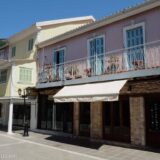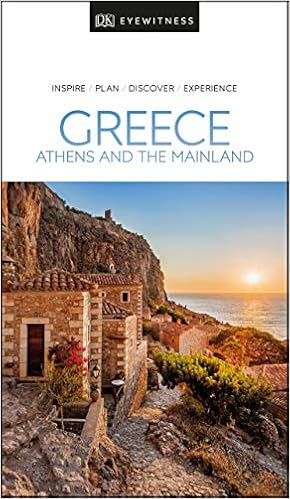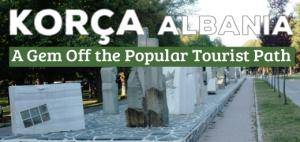Picturesque Towns of Western Greece You Should Visit
- Pinterest611
- Facebook0
- Twitter2
- Reddit0
- Flipboard0
- Email3
- Buffer13
- 629shares
- Like
- Digg
- Del
- Tumblr
- VKontakte
- Buffer
- Love This
- Odnoklassniki
- Meneame
- Blogger
- Amazon
- Yahoo Mail
- Gmail
- AOL
- Newsvine
- HackerNews
- Evernote
- MySpace
- Mail.ru
- Viadeo
- Line
- Comments
- Yummly
- SMS
- Viber
- Telegram
- Subscribe
- Skype
- Facebook Messenger
- Kakao
- LiveJournal
- Yammer
- Edgar
- Fintel
- Mix
- Instapaper
- Copy Link
The mainland of Western Greece is comparatively less-visited by tourists. Yet you will find some really picturesque small towns in this part of Greece. This post follows our road trip route coming from Albania, and introduces you to a number of smaller towns worth a visit.
![The mainland coast of Greece has many picturesque towns you should visit by car or motorhome. These towns are cheaper to reach than the famous Greek islands. [Photo is of a sunset behind a large sailing boat in Plataria.]](https://dare2go.com/travel/wp-content/uploads/2020/07/west-greece-featured.jpg)
The mainland coast of Greece has many picturesque towns you should visit by car or motorhome. These towns are cheaper to reach than the famous Greek islands. [Photo is of a sunset behind a large sailing boat in Plataria.]
What you will find in this article:
The Bay of Plataria
Plataria is one of the first towns you will encounter when coming from the north. Whilst it is not as picturesque as some other small coastal towns, its location makes it worth a stopover. Sheltered inside a large sweeping bay, it has a long sandy beach and a nice port. There are still a number of plots left in town with no houses built on, showing that it’s a bit out of the way.
The title image above (with the sailing ship in front of the setting sun) was taken in Plataria.
The Beautiful Town of Parga
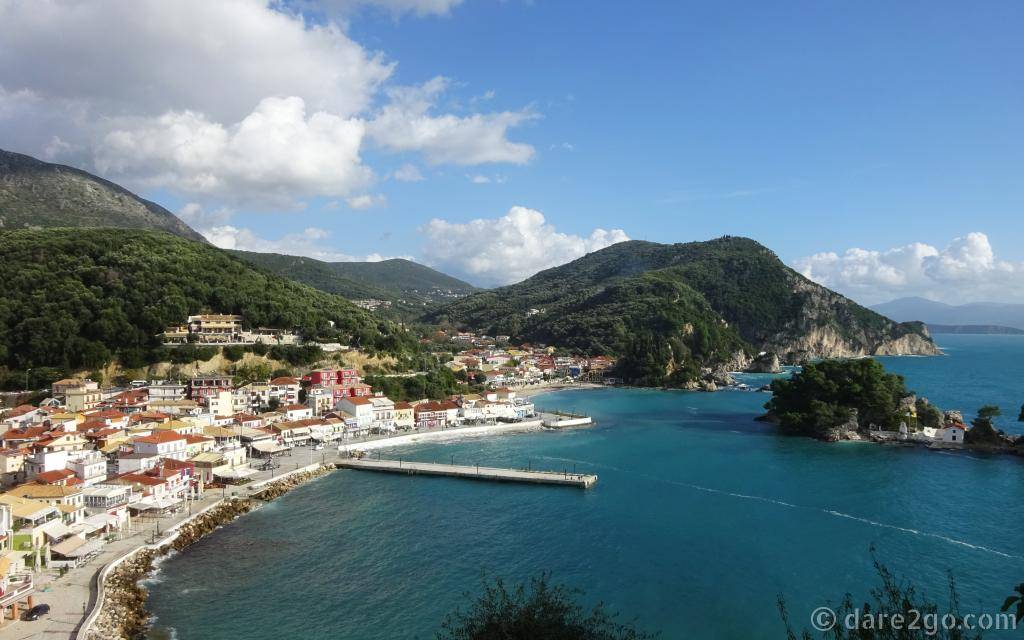
The waterfront of Parga as seen from the castle. On the right, the tiny island of Panagia with a small orthodox church.
Down along the coast you will come to Parga next. It’s a former, classic Greek fishing village with narrow, crooked lanes and shaded, steep stairways leading to houses further up the hill. The old town around the small fishing port is all pedestrianised and taken over by businesses living from tourists. The waterfront is lined with restaurants and bars – as everywhere else in Greece.
Parga has two landmarks, which make the town really photogenic. On the hill to the west are the well-preserved remains of a Venetian castle overlooking the horseshoe-shaped bay. You can visit the castle in season. (It was locked up when we first came through in November.) On Tuesdays it’s closed.
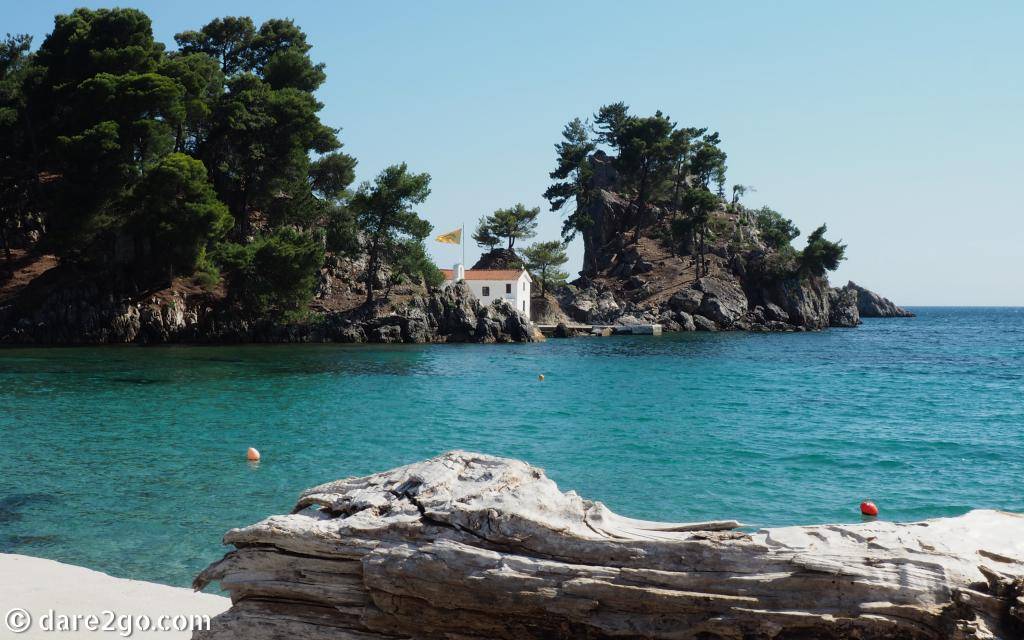
The island of Panagia seen from the waterfront promenade
Right across from the port is Panagia Island, with a small orthodox church on it. The island is so close that you can swim across to its tiny sandy bay (providing you are a confident swimmer).
There are two small sandy beaches near the town, which can be fairly crowded in peak season. Nearby, there are other sand beaches, but you will have to drive to them.
The Island and Old Town of Lefkas, or Lefkáda
Whilst not part of the mainland, strictly speaking, we include Lefkáda because you don’t need to take a ferry to get to this island; it’s connected to the mainland by a floating pontoon bridge. (When we re-visited in late June 2020, the original bridge had been removed for repairs and replaced by an anchored ferry stretching across the narrow waterway.)
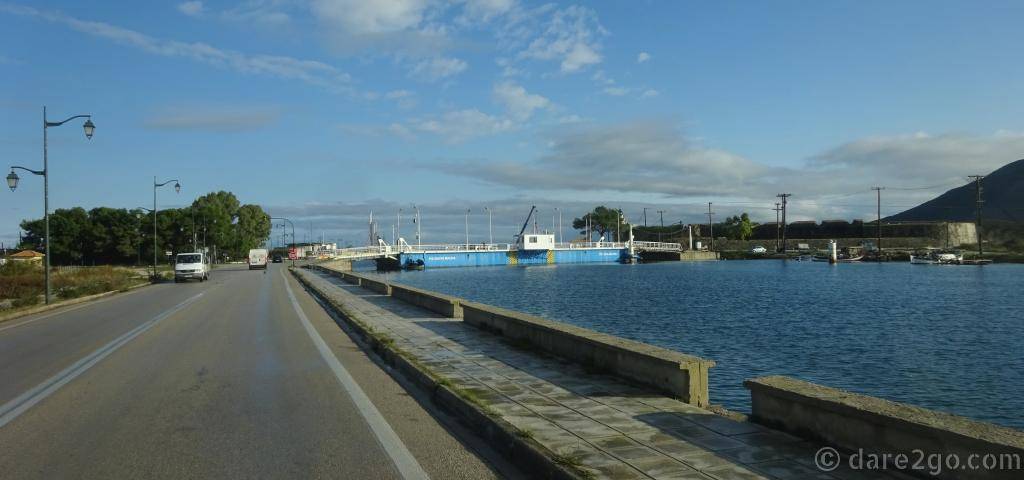
The blue barge on the right connects Lefkada Island with the mainland. In the background one of the old Venetian fortifications.
The direct road connection to Lefkas gives you the chance to explore a Greek island without having to take a boat ride!

One of the squares in the old town of Lefkas (Lefkada)
Although Lefkas is a popular tourist destination, it hasn’t lost its charm. We stayed several nights right by the main town. Lefkas or Lefkáda (same name as the entire island) has very unique and intriguing architecture: most of the houses were rebuilt after an earthquake and consequent tsunami in 1825, using galvanised iron or tin cladding on timber framing.
This is a style of architecture we are more familiar with from remote regions that are considered as “Pioneer Country”. We have seen many iron-clad buildings in Patagonia and in the Yukon, where the ease of transporting prefabricated houses into remote locations promoted this style of architecture.
We were surprised to find metal-clad houses in Greece, where normally older structures are built from natural stone. We had to search the internet for background information on this rare occurrence. Three factors contributed to this unique style:
- Lefkada was under British rule at the time of the earthquake in 1825; the British were in charge of the engineering
- the ease of rebuilding and obvious time-saving
- they are more flexible than stone houses, and therefore less prone to severe earthquake damage.
The town follows its ancient layout and is full of narrow lanes that no car can fit through. The advantage of this is that you walk in part shade most of the day. The older section is not laid out in an obvious grid pattern, so you might easily find yourself in a dead-end. Nevertheless, it’s a lovely place to wander around aimlessly and photograph the sometimes fairly dilapidated, or often beautifully renovated old houses. Three storey structures are mostly an exception in Lefkas.
Please click thumbnails below for a larger photo with description.
- Old iron clad houses along the pedestrian zone of Lefkas
- The earthquake-safe building style in Lefkas has led to these unusual steel bell towers
- One of the many narrow lanes in Lefkas; only wide enough for motor bikes and scooters.
- A corrugated iron clad house with lots of quirky found-objects on the footpath
Around the Island of Lefkada
We drove around the island twice. Both times, we would have loved to spend more time exploring every nook and hidden small village. But sadly in early December, we had drizzling rain and low cloud; in June, we only had a handful of remaining Schengen Visa days before we had to leave Greece…
The Paralia Agios Ioannis beach to the west of the town of Lefkada is dotted with old windmills, an indication as to why nowadays, kite surfers are attracted to this part of the island’s coast. Lefkada has a large marina right at the edge of town. In the south the small towns of Vassiliki and Syvota also have sizeable marinas, encouraging yachts to visit the island.
Along the west side of the island, the main road winds through hills dotted with olive trees. Narrow dead-end side roads zigzag down to some of the prettiest sand beaches of the Ionian Sea. Several of these beaches are so picture-perfect that photos of them are often used to promote tourism in Greece. Of course, this contributes to the popularity of Lefkada Island as a destination.

An old windmill standing at the Agios Ioannis beach near Lefkas, with a kite surfer in the background.
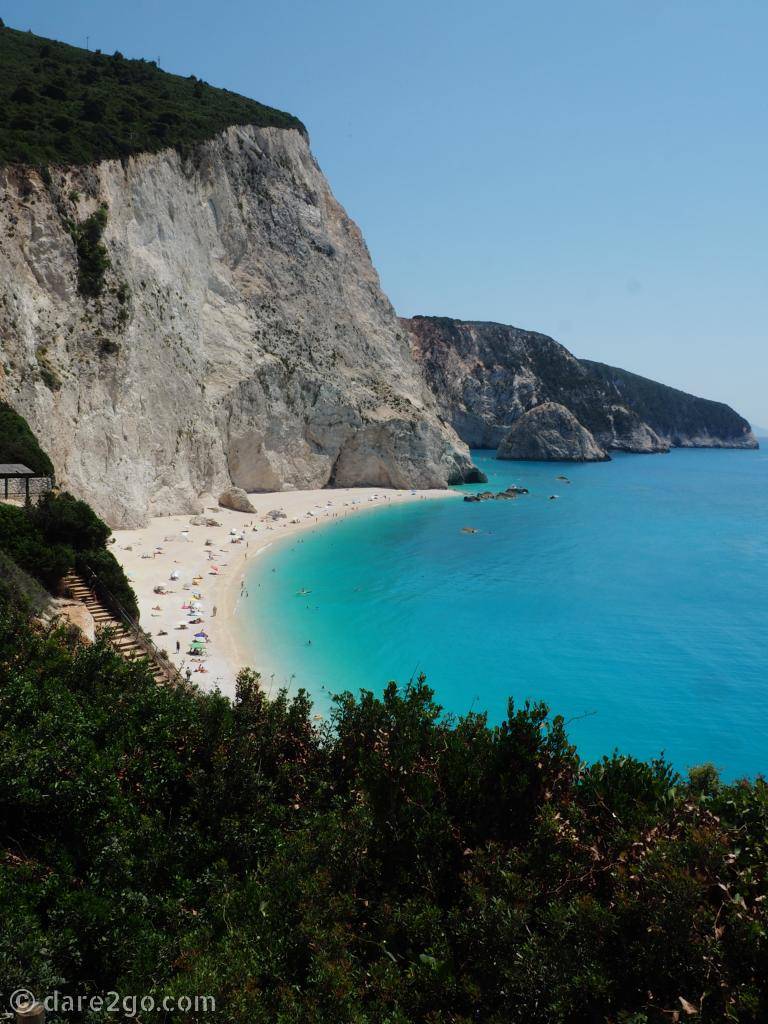
This is the beautiful white sand beach at Porto Katziki on Lefkada
The east coast is less mountainous, and nearly flat the closer you come back to the main town. Here you find a fairly sheltered inlet with a few small sandy bays and many more anchorages for yachts. This part of the island is also more built-up. The inland has retained its rural character with small olive farming communities, among which you will find some lovely hiking trails.
Historic Messolóngi and its Lagoon
You would probably bypass Messolóngi if not for its two unique attractions: the Garden of Heroes and the National Park of Mesolongi-Etoliko.

A very small section of the Garden of Heroes; in the foreground a French statue honouring their fallen citizens.
Among them is a statue of the British poet Lord Byron, who joined the movement and died here. Most are fairly ordinary statues, but a few stand out thanks to their style. Lord Byron is still held in high regard for his sacrifice and his statue is a centrepiece of the park.
The surrounding lagoons gave the town its name, which loosely translates to “amidst lagoons”. The 150 km2 National Park of Mesolongi-Etoliko is recognised as an important habitat for the protection of hundreds of waterbird species. This makes it a great destination for bird watchers!
![Sunset behind one of the fishermen's huts in the lagoon of Messolóngi [photo credit ]](https://dare2go.com/travel/wp-content/uploads/2020/07/Messolongi-Lagoon.jpg)
Sunset behind one of the fishermen’s huts in the lagoon of Messolóngi [photo credit ]
The Regional Centre of Nafpaktos

The Venetian fortress dominates the hill behind Nafpaktos
Of all the towns included here, Nafpaktos is the largest. It is located near the new Rio-Antirrio Bridge to the Peloponnese. The town is a busy regional centre with a lovely flair. There are a few sights, which make a visit worthwhile.
The first sight you’ll notice (after the enormous highway bridge) is a large Venetian fortress taking up most of the mountain above town, with its walls coming all the way down the steep slope. For the Venetians, this was an important strategic position, controlling all access into the Gulf of Corinth.
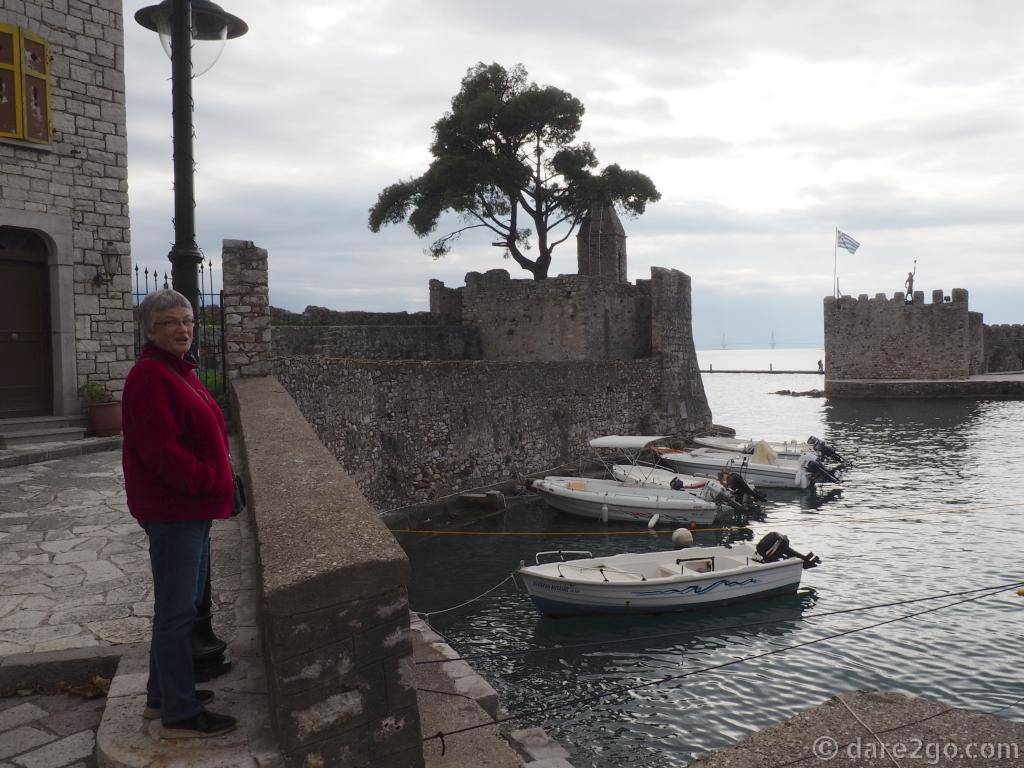
The old fortified Venetian port of Nafpaktos
In the centre of town, there is a small fortified port, just big enough for maybe a dozen regular fishing vessels. The port was constructed to harbour Venetian war and supply ships. Now it’s lined with outdoor cafes and restaurants. You will find Nafpaktos’ tourist information right opposite the old port. The Fethiye Mosque is a reminder of the city’s Ottoman past and the largest still-standing Ottoman-era mosque in Greece.
Along the town’s shore stretch its beaches, which are a little coarse with more pebbles than sand.
Galaxídi, famous for its Maritime History
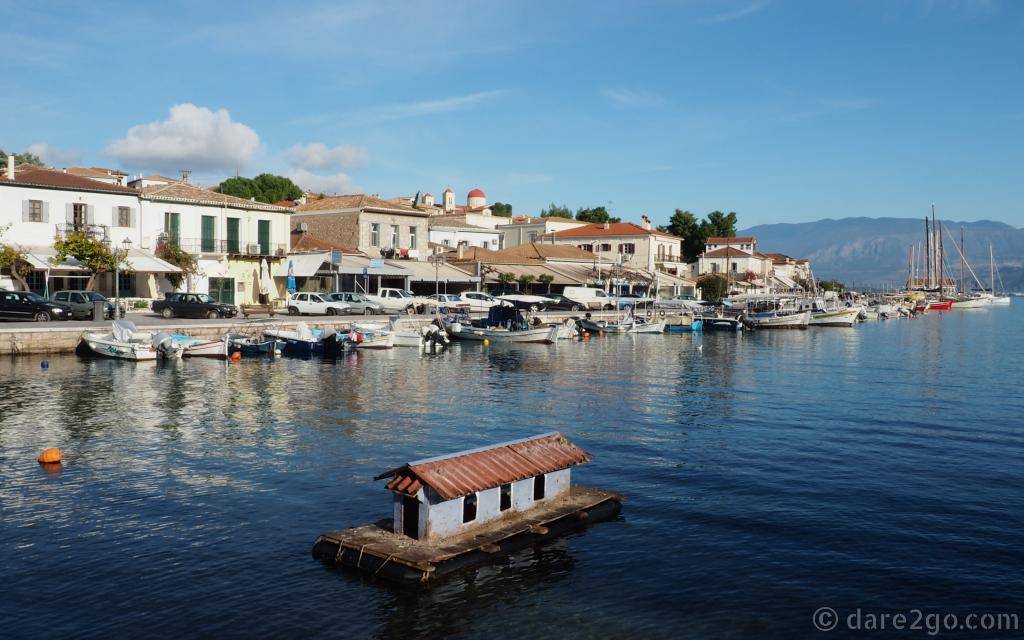
The laid-back, picturesque waterfront of Galaxidi
Until 1950, the small town of Galaxídi was not accessible by road; the only means to get to it was by boat. It’s hidden in a small bay by a hilly peninsular covered in pine forest. Once the whole town was surrounded by forests, which supplied the timber for the town’s then flourishing shipbuilding industry.
The skilled shipbuilders and captains from Galaxidi were highly respected, some worked as far away as Messolongi and Nafpaktos. In the 18th and 19th centuries, their fame reached well beyond Greece. Several captains from Galaxidi were respected members of the court of Ali Pasha of Ioannina. However, when steamships began to populate the seas, Galaxidi didn’t adjust and its sailing fleet lost its importance.
Today, many substantial Neo-Classical houses of the former shipbuilders and captains are still preserved around its two ports. Several of these protected buildings are now occupied by upmarket seafood restaurants. The compact Nautical Museum recalls the town’s glorious past.
To the north of the town is a long and narrow, mostly sandy beach.
TIP:
It’s only 34 kilometres from Galaxidi, via the busy town of Itea, to the World Heritage listed site of Delphi . This is one of Greece’s most important archaeological sights. It’s an easy and attractive day trip.
Map of the Picturesque Towns in West Greece

Our road trip route along the coast of West Greece. We came from Albania (top left corner) and continued towards Thessaloniki in the North-East.
Visit the Andalucía White Villages on a Scenic Roadtrip
10 Places to See near Prague on a Czech Road Trip
Additional Tips for Motorhomes
Greece has some truly picturesque places to stay a night or two with a motorhome. If you’re really lucky, you will find a spot away from houses and the typical barking dogs.
We visited the region out of season when most camping places were closed. Then the police are quite easy-going and tolerate free camping if you are not staying for days in the same location. Some ocean-front sites are under the jurisdiction of the Coast Guard of Greece, who seem to take a tougher stance on wild camping. During the peak summer season, you can expect to be sent to a campground.
Please leave all camping locations at least as clean as you find them! We sometimes pick up the rubbish others have left behind. To refill with water doesn’t seem to be a problem anywhere in Greece. You often find taps (faucets) in town squares or at cemeteries.
This book is for travellers who are more interested in the sights than recommendations for restaurants or hotels. The new edition DK Eyewitness Travel Guide for the Greek Islands is due for release in early 2021.
Practical Advice for Greece
Greece is part of the European Union and a member of the Schengen. As such you have the Euro as a currency and the normal Schengen entry requirements.
Museums and most archaeological sites are closed on Tuesdays (not Mondays as in other countries), so plan your sightseeing accordingly!
Conclusion
If you are not keen on ferry transfers back and forth to one of Greek’s many islands, you might want to explore the Western Mainland of the country. It’s less touristic than other parts and has many picturesque towns to visit.
Maybe hire a car and see these places on a round trip. This way you could pass by several of the famous orthodox monasteries in the inland, which cling to the tops of steep mountains like eagle nests.
Please share this post on Pinterest to show your friends or to remember for later:



- Pinterest611
- Facebook0
- Twitter2
- Reddit0
- Flipboard0
- Email3
- Buffer13
- 629shares
- Like
- Digg
- Del
- Tumblr
- VKontakte
- Buffer
- Love This
- Odnoklassniki
- Meneame
- Blogger
- Amazon
- Yahoo Mail
- Gmail
- AOL
- Newsvine
- HackerNews
- Evernote
- MySpace
- Mail.ru
- Viadeo
- Line
- Comments
- Yummly
- SMS
- Viber
- Telegram
- Subscribe
- Skype
- Facebook Messenger
- Kakao
- LiveJournal
- Yammer
- Edgar
- Fintel
- Mix
- Instapaper
- Copy Link

